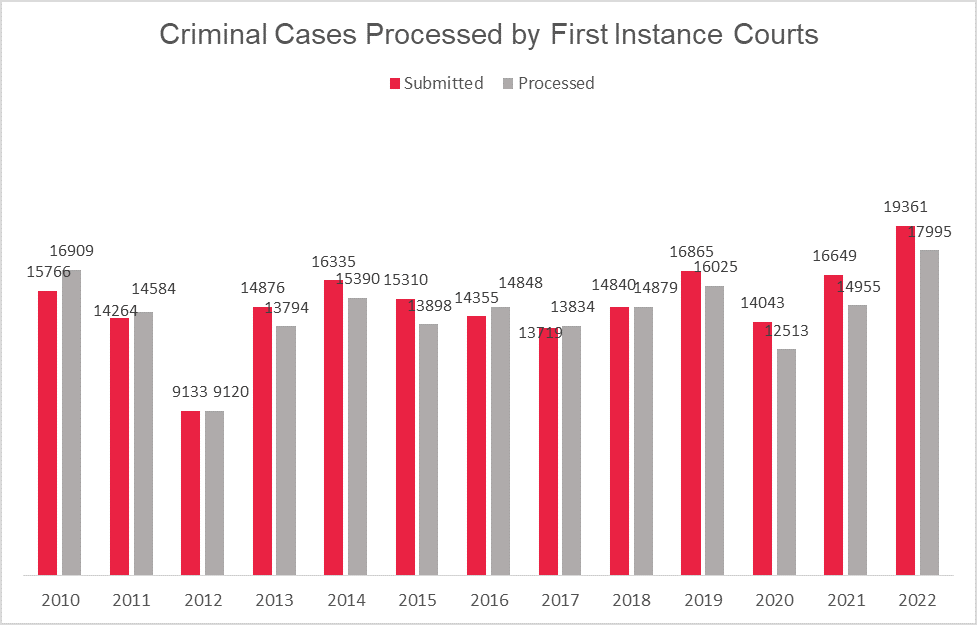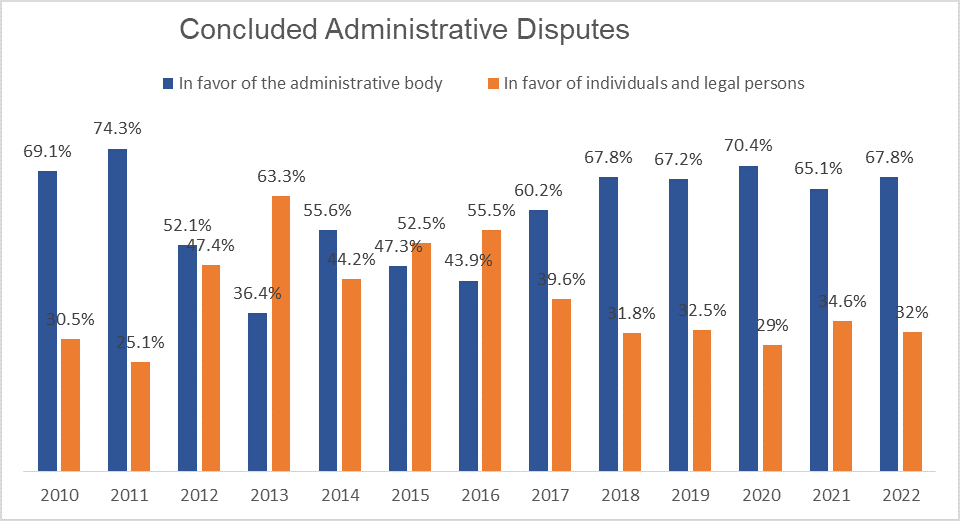


The courts of various instances of Georgia produce statistics according to the statistical forms developed by the Supreme Court, which are sent to the Supreme Court. Meanwhile, the Supreme Court produces statistical reports according to the data reflected in the statistical forms.
For years, the Supreme Court published the main statistical data of common courts quarterly on its website and annually published a collection of statistical data "Justice in Georgia", which presented statistical data of common courts in more detail. For easy access to users of statistical reports pro-actively published by the Supreme Court, IDFI has developed a software tool that provides data visualization and ensures the availability of statistical data in a machine-readable format. Starting from 2021, the publication of statistical information on the website of the Supreme Court has been delayed significantly. This is likely to be related to the process of introducing a new software system for the Supreme Court's new website and statistics production.
On February 23, 2023, IDFI addressed the Supreme Court of Georgia with a Freedom of Information request about the statistical reports for the years 2021 and 2022, which were not made proactively available on either their old or new website. On April 12, 2023, after the submission of an administrative complaint, the Supreme Court provided IDFI with the main statistical data for 2022 and the statistical collection "Justice in Georgia" for 2021. Regarding "justice in Georgia" for 2022, the Supreme Court explained that the said data was currently being processed. After providing statistical reports to IDFI, the mentioned documents were also published by the Supreme Court on its new website.
As of today, court statistics for 2022 are only available based on the overall statistical data on the general courts of Georgia. therefore, below we present the analysis of the trends derived from the data for the years 2010-2022, disaggregated by categories of court cases.
- In the years 2010-2022, the highest number of criminal cases (19,361) were filed in the courts of first instance in 2022.

- In 2022, compared to the previous year, the number of criminal cases filed in courts increased by 16.3%, and the number of pending cases increased by 20.3%.
- In 2022, a plea agreement was signed in 68.4% of cases concluded with a verdict (11,865 cases). The highest share of plea agreements (89.1%) was in 2013.
- The share of acquittals (9.5%) and partial acquittals (4.3%) in 2022 is one of the highest rates in 2010-2022.
- In 2022, 4,830 persons (38.5%) were sentenced to detention as a preventive measure by the courts as a result of petitions received from investigative bodies, while 7,711 persons were granted bail and other non-custodial measures (61.5%). The lowest rate of detention was in 2013 at 26.8%.
- From 2013, until 2020, the rate of courts of appeals upholding the verdict of the previous instance court increased every year and reached 87.5% as of 2020. As of 2022, this rate is down to 83.8%.
- In 2022, 1,358 cassation appeals were submitted to the Supreme Court, which is 25% more than the previous year. In the case of the Supreme Court, 95.2% of the appealed court decisions were upheld in 2022 which is the highest rate throughout 2010-2022.
- In 2022, 14,152 administrative cases were submitted to the first instance courts, which is 8.6% more than the previous year;

- In 2022, 67.8% of administrative cases (5819 cases) were concluded in favor of administrative bodies, 32% (2,746 cases) in favor of individuals and legal entities, and 0.2% (18 cases) were settled.
- Since 2018, the rate of administrative cases concluded in favor of individuals and legal entities has been decreasing. For example, in years 2012-2017, this figure ranged from 40% to 63%, and in 2018-2022, from 29% to 35%.
- Although the majority of administrative cases in the first instance conclude in favor of administrative bodies, in 2021-2022 administrative bodies were more likely to address the courts of appeals than individuals and legal entities.
- In 2022, administrative penalties were imposed upon 13,645 persons, which is 46.9% more than in 2021.
- In 2022, 97,557 civil cases were filed in first instance courts, while 46,494 cases were processed.
- In 2021-2022, about as many people were denied a civil lawsuit as in 2010-2020 combined.
- The rate of lower instance decisions being upheld is higher for administrative and criminal cases in comparison to civil cases.
The analysis of the overall statistical data received from the Supreme Court of Georgia shows that in 2022, compared to the previous year, the number of appeals to the court for all three categories of cases has increased.
The highest rate of criminal cases filed since 2010 was recorded in 2022, which can to some extent be attributed to the deterioration of the criminogenic environment in the country. It is worth noting that the share of acquittals in criminal cases has significantly increased in the last 5 years, which on the one hand may be due to the raising of the standard of evidence required by the court to prove guilt, and on the other hand to the increase in the number of criminal cases conducted by investigative agencies in an unqualified manner.
Despite the fact that in 2022, the rate of imposing prison sentences was historically low, the use of pre-trial detention as a preventive measure at the request of investigative bodies is still high. For example, in 2013, the share of imprisonment sd correctional measures decreased to 26.8%, although it increased significantly again in the following years. It is worth noting that in 2022 pre-trial detention was applied to more individuals than persons were convicted to serve in prison.
In terms of administrative cases, It is important to mention the number of court decisions made in favor of individuals and legal entities has reduced and the number of decisions upheld by courts of appeals has increased since 2018. against this background, the high rates of appeals by administrative bodies to higher authorities, to a certain extent, indicate the maximal use of state resources when dealing with individuals and legal entities.
The years 2021-2022 were also distinguished by high rates of denying civil lawsuits. in particular, in 2021-2022, about as many people were denied a civil lawsuit as in 2010-2020 combined. this statistic will probably be significantly improved in the following years by the decision of the Constitutional Court, according to which several legislative norms were abolished, which could have been the basis for denying various types of civil lawsuits.
____

The analysis was prepared by the Institute for Development of Freedom of Information (IDFI). It was supported by a grant from Luminate. IDFI is responsible for the content of this document. Views expressed in therein do not reflect the position of Luminate.